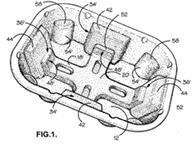The availability of a Formstein or Gillette-type defence to infringement under the ‘equivalents’ approach has been an open question. This case shows that such a defence is available and provides a legal reasoning for how it will fit into the existing infringement test.
The Actavis case changed the UK’s approach for assessing whether features of a product which are equivalent to those in a patent claim, infringe the claim. Since then, the availability of a Formstein or Gillette-type defence to infringement under the ‘equivalents’ approach has been an open question. This type of defence could prevent overreach of the UK’s patentee friendly approach to equivalents. The defence is that an ‘equivalents’ argument cannot be used to broaden the scope of protection, if the equivalents encompassed within that broader claim scope are obvious over the prior art. This type of defence seems essential to preserve the symmetry between validity and infringement.
This Vernacare v MFP case shows that such a defence is available and provides a legal reasoning for how it will fit into the existing ‘Actavis’ test for assessing infringement.
The case involved two patents owned by Vernacare; GB 2446793 (the ‘793 Patent), and GB 2439947 which both related to moulded fibre wash bowls. Vernacare began infringement proceedings against their competitor MFP.
The ‘793 patent had been litigated earlier in Vernacare v. Environmental Pulp Products [2012] EWPCC 41, where the Judge had held that the patent was valid and infringed.
The washbowls of the ‘793 patent;

were found to be advantageous because:
“By providing recesses in the enclosing wall, it is not necessary to rely on a peripheral lip in order to lift the bowl when full and thus the likelihood of disintegration of a filled bowl is greatly reduced. In addition, by having recesses in the enclosed wall, a more rigid structure is produced.”
MFP’s product was found to lack separately defined recesses, instead having a more pronounced continuous ridge running around the whole bowl:

Under the normal purposive interpretation of the claim wording, the Judge held that the claim was not infringed. This was because the continuous sinusoidal ridge of the alleged infringement did not constitute “recesses” in the enclosing wall according to a normal interpretation of the claim wording.
Following this analysis, the Judge then assessed whether the sinusoidal ridge was in fact an equivalent of the recesses, under the Actavis questions. This approach is now routine in infringement cases in the UK. Vernacare argued that MFP’s sinusoidal ridge was the functional equivalent of recesses and that the claim was therefore infringed. The Judge agreed that the sinusoidal ridge did in fact achieve the same result in substantially the same way as the recess of the claim. So far, nothing unusual….
However, the third Actavis question was then considered, namely; ‘did the patentee intend that a strict compliance with the literal meaning of the claim was an essential requirement of the invention?’.
The Judge decided that the answer was, ‘yes’- strict compliance with the literal meaning was intended. To do otherwise, and apply a loose compliance with the wording, would expand the meaning of ‘recess’ to encompass the sinusoidal ridge. The sinusoidal ridge itself was found to be obvious over the prior art. It could not therefore be covered by a valid claim.
This finding meant that the sinusoidal ridge could not be considered as an equivalent of the ‘recess’ claim wording. MFP therefore avoided infringement. They essentially used a Formstein/Gillette-type defence, which was accessed via the third Actavis question about whether there should be strict compliance with the literal meaning of the claim wording.